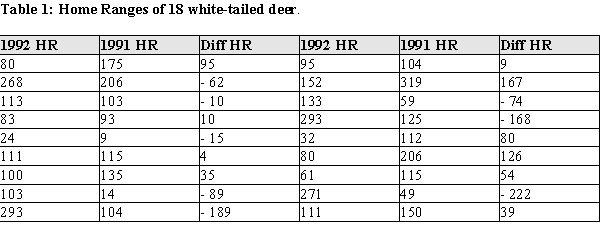Essay
The home range of an animal is the average area an animal occupies while foraging for food and defending its territory. It is thought that home ranges of animals usually do not change much, except when an area is under ecological stress. As part of a study of white-tailed deer in Florida in 1991 and 1992, deer were radiocollared and their movements followed over the course of a year. The home range data for a random sample of 18 white-tailed deer are shown below in Table 1. The raw area of the home range for each of the deer is reported in hectares for the years 1991 and 1992. (A hectare is a metric unit of area equal to 2.471 acres.) The investigators are interested in determining whether the home range white-tailed deer change over the course of as little time as a year.  a) Using graphical display(s) of your choice show that the assumptions necessary for determining a change in the mean home ranges are plausible. b) Construct a 95% confidence interval for the difference in means of the home ranges from 1991 to 1992. c) Do the data provide evidence of a change in the size of the home ranges between 1991 and 1992? Provide statistical justification for y.
a) Using graphical display(s) of your choice show that the assumptions necessary for determining a change in the mean home ranges are plausible. b) Construct a 95% confidence interval for the difference in means of the home ranges from 1991 to 1992. c) Do the data provide evidence of a change in the size of the home ranges between 1991 and 1992? Provide statistical justification for y.
Correct Answer:

Verified
a) There is no information that the de...View Answer
Unlock this answer now
Get Access to more Verified Answers free of charge
Correct Answer:
Verified
View Answer
Unlock this answer now
Get Access to more Verified Answers free of charge
Q8: The teacher noticed that 13 out of
Q9: Are the given hypotheses essentially the same?
Q10: Viruses are infectious agents that often cause
Q11: In many animal societies, a role assumed
Q12: Suppose you need to estimate a difference
Q14: Suppose that you wish to compare two
Q15: For two independent samples, <img src="https://d2lvgg3v3hfg70.cloudfront.net/TB7678/.jpg" alt="For
Q16: The teacher noticed that 15 out of
Q17: When comparing two population means, it is
Q18: When comparing two population means, it is